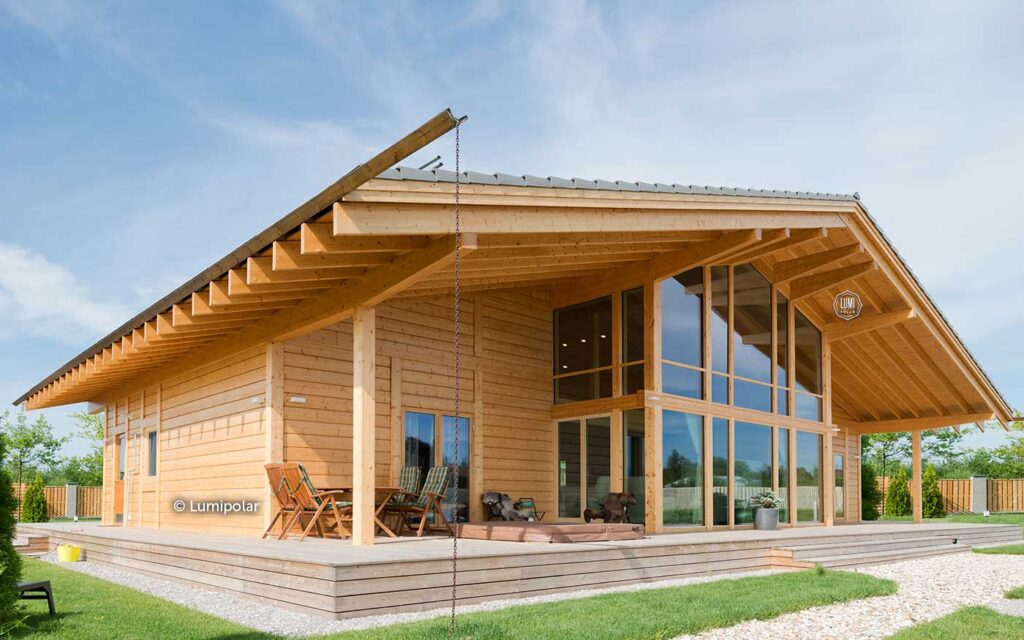The image of half-timbered houses—with their distinctive exposed wooden frames and white or coloured infill panels—is a beloved part of Britain’s architectural heritage, particularly in counties like Cheshire and Warwickshire. This traditional construction method, known on the continent by its German name, Fachwerk, represents one of the earliest and most enduring forms of timber construction.
While the methods of the 15th-century craftsman and the 21st-century engineer differ significantly, the fundamental concept remains the same: a structural wooden skeleton that bears the load of the building. Today, this ancient principle has been completely revolutionised to create the modern timber frame construction that is rapidly becoming a cornerstone of sustainable building in the UK.
From Medieval Half-Timbering to Modern Timber Frame
The German term Fachwerk literally translates to “compartment work” or “panel work,” referring to the framed sections (Gefache) filled with materials like wattle and daub, brick, or stone. The English equivalent, half-timbering, shares this structural DNA:
- Traditional Fachwerk/Half-Timbering: Focused on large, heavy timbers (often 15 to 30 cm thick) joined using complex, load-bearing mortise and tenon joints secured with wooden pegs. The structure was often aesthetically exposed.
- Modern UK Timber Frame: The aesthetic is typically covered, but the principle is a structural frame built from smaller, precision-engineered timber sections. This method is predominantly an off-site construction technique, where walls, floors, and roofs are manufactured as highly accurate panels in a factory setting.
This shift to off-site manufacturing is the biggest transformation, turning a centuries-old craft into a high-tech, Modern Method of Construction (MMC) essential for meeting Britain’s demanding housing and climate goals.

Why Modern Timber Frame is the UK’s Go-To Solution
Timber frame construction has surged in popularity across the UK, especially in Scotland where it accounts for a majority of new homes. Its rise is driven by key benefits that traditional brick-and-block construction struggles to match.
1. Speed and Efficiency
Modern timber frame systems are built to exact factory specifications. This leads to:
- Faster Build Time: Panels are assembled on-site rapidly (often in a matter of days), significantly reducing the overall construction programme and labour costs.
- Weather Resilience: Because the structural elements are fabricated in a controlled factory environment, adverse weather delays are minimised once the frame is erected, offering a reliable build schedule.
2. Superior Thermal Performance
Energy efficiency is paramount in new UK building regulations, and timber frame excels here.
- Excellent U-Values: Modern closed panel and Structural Insulated Panel (SIP) systems allow for high levels of insulation (pre-installed in the factory), delivering superior U-values and thermal performance.
- Airtightness: The precision engineering of off-site construction ensures exceptional airtightness, which is crucial for achieving high-performance standards like Passivhaus. The result is a warmer home with significantly reduced energy bills.
3. Sustainability and Low Carbon Footprint
Wood is the ultimate renewable building material, placing timber frame at the heart of the UK’s net-zero agenda.
- Carbon Sequestration: As trees grow, they absorb CO2. By storing this carbon within the structure of a home, timber construction actively contributes to reducing atmospheric carbon.
- Embodied Carbon Reduction: Timber requires far less energy to fell, mill, and transport than concrete or steel, substantially lowering the embodied carbon of the build.
Open Panel vs. Closed Panel Systems
The evolution of modern timber frame has resulted in two primary systems used in the UK today, each offering varying levels of off-site completion:
Open Panel Systems
- Description: Structural panels comprising timber studs, rails, and sheathing on one side, with a breather membrane.
- On-Site Completion: The cavity for insulation, and the application of vapour control layers, is completed on-site. This offers flexibility for on-site trades.
Closed Panel Systems
- Description: Highly engineered panels that are essentially pre-finished walls. They include the structural frame, insulation, and often the vapour control barrier and services battens pre-installed in the factory.
- On-Site Completion: These panels can arrive with windows, doors, and external cladding already integrated, drastically reducing on-site work and speeding up the construction to ‘weathertight’ stage.
Aesthetic Flexibility: The New Half-Timbering
While traditional half-timbering exposed its frame as a feature, modern timber frame allows for total aesthetic flexibility. It provides the core structural skeleton, which can then be clad in virtually any material to suit the architectural style or local planning requirements.
A modern timber frame home in the UK can look like a traditional:
- Brick-and-block house
- Stone-clad cottage
- Rendered contemporary design
In a nod to the Fachwerk heritage, some contemporary architects are now deliberately exposing sections of the structural glued laminated timber (glulam) in high-end, minimalist designs, often pairing the warmth of the wood with vast expanses of energy-efficient glazing. This creates a striking, modern interpretation of the historical timber skeleton.
In conclusion, while the visible half-timbered houses of Britain serve as a charming link to the past, the underlying principle of a structural timber frame is driving the future of UK housebuilding. Modern timber frame construction—the efficient, sustainable successor to the ancient Fachwerk—is essential for delivering the high-quality, energy-efficient homes the nation needs.



